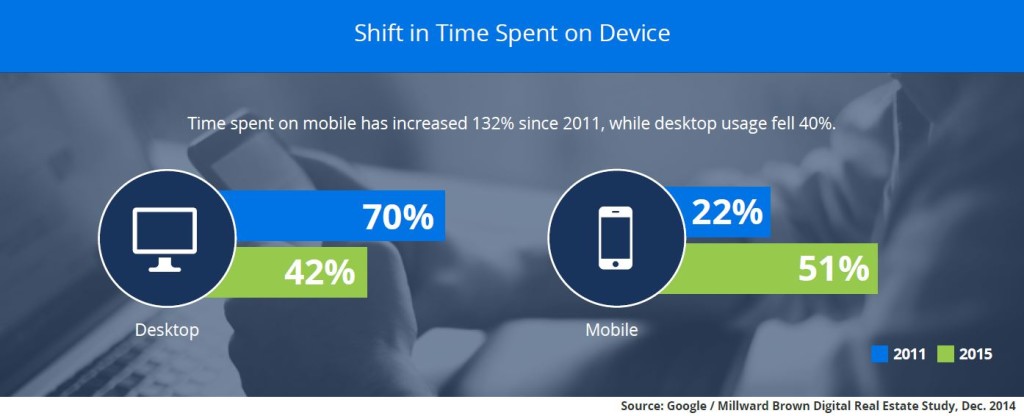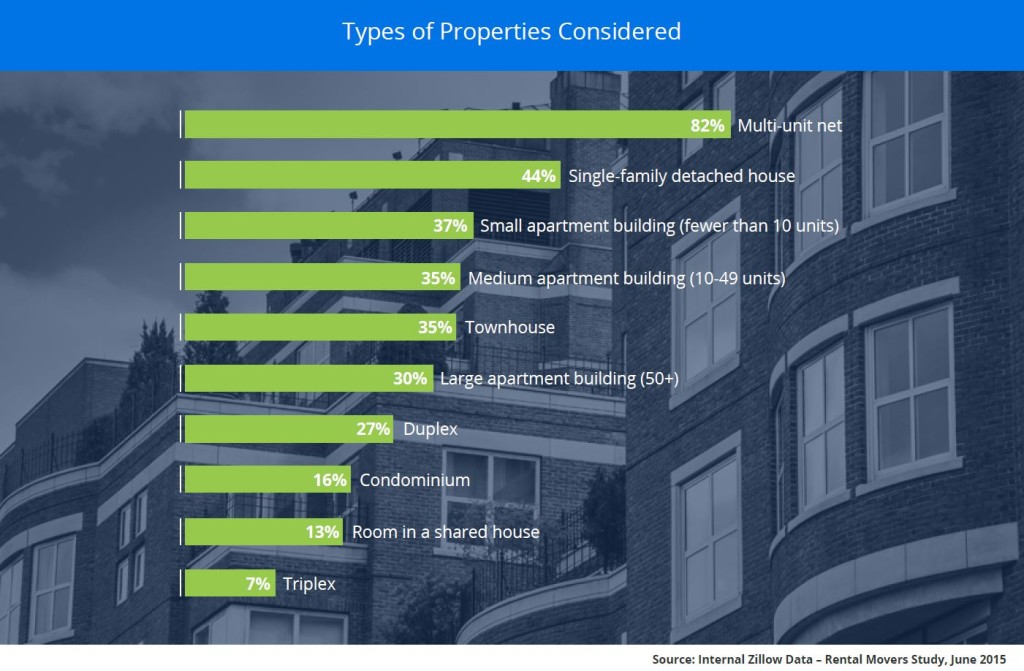Renter Acquisition: 6 Ways to Enhance Your Mobile Presence

November 15, 2015
8 min read
How many times have you been asked, “What’s our mobile strategy?” How do you respond? Do you have a plan? If you are like nearly two-thirds of companies recently surveyed by Adobe, the answer is no. Yet,
according to the same report, “The rise of mobile is the biggest catalyst of change in marketing today.”
Between all the hardware, software, consumer preferences, design trends and overall rapid pace of change, mobile can be hard for marketers to get their arms around. However, with two out of three renters using mobile to compare and discover new properties, the platform—and what it means for your leasing business—can no longer be an afterthought of your renter-acquisition strategy.
Mobile: Everywhere and always on—just the way renters want it
According to the Pew Research Center, 64 percent of American adults own a smartphone. However, mobile goes way beyond the phone and includes tablets, wearables (like watches) and even the touch-screen dashboard in your car. Regardless of the device, the vast majority of people—85 percent—say mobile is central to their everyday lives.
What does this mean for multifamily professionals? Your potential renters are visiting websites, researching, making purchases, booking rides, watching videos and so much more all from the palm of their hand—24 hours a day, seven days a week. And, they expect to be able to do it all instantly. What do they see when they visit your property’s website or start searching for an apartment home in your area?
If you’re trying to attract new residents to your property, mobile—and all of its quickly-evolving touchpoints and marketing opportunities—is essential to renter acquisition.
Mobile is an immediacy platform. It’s not a sit down, take your time with a cup of coffee and ask a bunch of questions platform. It’s a “give me the information, give it to me now — I have five minutes on the bus” platform. Renters want things quickly. Everyone expects things immediately. That’s part of why mobile took over.
– Jeremy Wacksman, Chief Marketing Officer, Zillow
“Mobile first” is now
Mobile has become our go-to method for accessing digital media and the Internet. In May 2015, Google reported more people conduct searches on mobile than on desktop. In addition, the time people spend on mobile now exceeds the time spent on desktop.

Interestingly, mobile has created new opportunities for media consumption and increased the total amount of time people spend on screens. Before modern smartphones, people would only use their mobile devices if they weren’t near their computer. Now, with fast processing and loading times, the value of switching to a computer has all but diminished.
Your potential renters are searching for their next home from the bus on the way to work or reading reviews while running an errand at lunch. They’re checking email before bed. The touch-Web world has fundamentally changed how your potential residents find and consume information about your community.
So much has the landscape shifted in favor of mobile that in April 2015, Google began penalizing websites that are not “mobile friendly.” Deemed the “Mobilegeddon,” this change in search rankings has resulted in a 10 percent decrease in organic traffic to sites that are not optimized for mobile.
Potential renters want valuable, easy-to-read and easy-to-tap information—and they want it instantly. If you can’t deliver, they will move on to the next property. Adopting a mobile-first mentality better aligns you with how renters shop for homes online.
Renters move fast. Does your mobile presence keep up?
It goes without saying that searching for an apartment home is intense. Your potential residents feel stressed and pressured by the fast, often harried process. Understanding your renters’ mindsets can help
you tailor a mobile experience that lets them find your community easily and sign a lease quickly.
Their search is short
Half of renter movers say they cram their search for an apartment home into eight weeks or less. They are often juggling job or family changes and searching for a new place to live at the same time. Desirable properties are rented quickly, and there is a sense that renters need to be the first to see the property or they won’t be able to lease it. They constantly refresh their searches, check websites and review notifications to get a jump on the newest openings.
They shop on the weekends
Your potential renters squeeze in their short search anywhere they can—on the bus, in a waiting room and in between errands—most likely on the weekends. Their mobile device makes this possible. Zillow’s
mobile traffic is affected by this trend. During the week, approximately two-thirds of search traffic occurs on a mobile device. On weekends, however, it spikes to over 70 percent.
They explore the entire marketplace of homes
When searching for their next home, renters view the entire real estate marketplace on mobile—not just apartment homes. Renters, in general, are twice as likely to consider and ultimately move into a multi-unit
apartment community over a single-family home, however they report looking at everything on the market, and one-third say they are looking to buy at the same time.

Your potential residents cast a wide net to accommodate their need to find a place and sign a lease quickly. The more you can do to ease the stress of their search by making it quicker and providing a functional and attractive website, the more your property will stand out. This is critical now that renters are comparing your property not only to the one down the street, but to all available properties in their search radius. An easy-to-use and easy-to-find mobile presence will go a long way toward helping renters in their frantic search.
Six ways to enhance your mobile presence
In order to reach more renters where and how they search, start developing a mobile-first approach for your community or portfolio. Work with your in-house team, agency or vendor to determine how to best
implement changes to your existing website or build a new one. Here are six ways to enhance your mobile presence so renters can discover your property and sign a lease.
1. Start simple
Small changes can make a big impact. You can start by requiring mobile screenshots to be part of every design project. You can also design for mobile first, or at least in parallel with your desktop design process.
Bring mobile top of mind during your planning sessions and think about how your potential renters are using their devices. Simple changes go a long way in helping shift to a mobile-first approach.
2. Embrace the mobile Web
While native apps may have a place in your marketing mix, renter acquisition happens on the mobile Web: This is where you will capture searchers and introduce them to your properties.  Apps are typically adopted by loyalists—you might think about building an app to help your current residents more easily submit rent payments or maintenance requests, for example. There is a place for both apps and the mobile Web in your digital strategy, but they serve different purposes and should address different needs.
Apps are typically adopted by loyalists—you might think about building an app to help your current residents more easily submit rent payments or maintenance requests, for example. There is a place for both apps and the mobile Web in your digital strategy, but they serve different purposes and should address different needs.
3. Build a great-looking site
Make a good first impression with a clean, easy-to-use site that looks great on every mobile device. Instead of jamming the full version of your desktop website into a four-inch screen, think through your potential renters’ use cases. How are they finding your site? Why are they searching? Then, create a helpful, simplified search and discovery experience. Determine what content you need to address your core use cases—pictures, property tours, forms—then display it so users can immediately home in on the relevant information.
Design matters—big time. It’s well worth the expense to invest in the services of a professional designer to overhaul and optimize your website for mobile. Also, make sure that ILSs and other third-party sites that feature your property look good and work well on mobile devices.
4. Focus on functionality
Visitors to your website expect, at a minimum, that it will work flawlessly—no matter what device they are using. Even minor annoyances can cause users to abandon your website (and find another property). Your potential renters don’t have the patience or time for long load times and shouldn’t have to manipulate your site by scrolling, pinching or zooming to make it readable.
Think about how other brands use mobile to help their customers. Check out hospitality, retail, financial services or any other brands you like interacting with on mobile, then evaluate what makes their mobile
presence great and extrapolate your learnings to your own website. For example, do your users want contact information immediately? If so, auto-populate forms or implement click-to-call or click-to-text. Give users the quickest route to take action—so they can sign a lease!
5. Deliver a valuable experience through personalization
Your potential residents expect you to show them relevant content, not the kitchen sink. This idea filters through all of mobile’s touchpoints and can include opt-in notifications (when inventory becomes  available, for example), location-based search, saved searches or even personalized email communications to those who have asked for more information—and don’t forget to optimize those email messages and subject lines for mobile, too.
available, for example), location-based search, saved searches or even personalized email communications to those who have asked for more information—and don’t forget to optimize those email messages and subject lines for mobile, too.
Personalization is about balance: Provide enough information to keep rental shoppers interested, but customize the experience to ensure your content is relevant and encourages renters to take the next step and contact you.
6. Leverage your social channels
If you’re noodling a mobile strategy, there’s a good chance you’re already tackling social. Social media help to improve your search ranking, and—even more importantly—it helps potential residents find you in places where they and their connections are already spending time. You need to be on the same channels so you can answer questions, help residents learn about your neighborhood, showcase your property and eventually convert a potential renter to a lease.
Conclusion
The paradigm has shifted. Mobile—the device, marketing channel, personal assistant and information hub—has become the central point of contact for your renters. With a 24/7 cycle, your properties need to be discoverable any time, from any device. Taking a mobile-first approach to renter acquisition can help you stay competitive. Whether you make small tweaks to your design process or completely overhaul your online presence, the bottom line is that your properties must be easy to find, and your website should create a great experience for rental shoppers so they can get the information they need—quickly and easily—to contact you and sign a lease.
Connect with us!
Learn how Zillow Rentals can help you reach your goals.
Stay informed. Stay ahead.
Access exclusive industry insights, market trends, and expert tips. Subscribe now to receive quarterly Zillow Rentals newsletters!